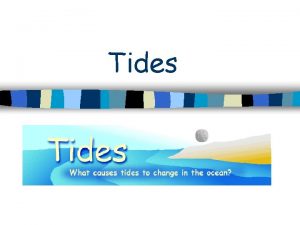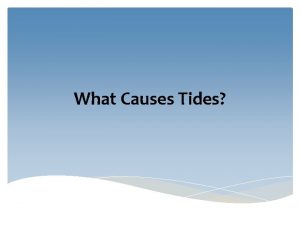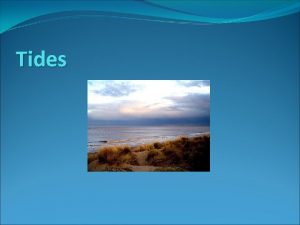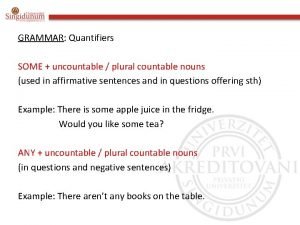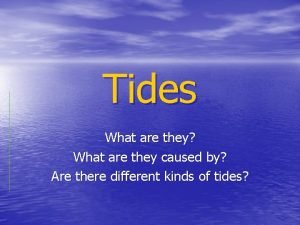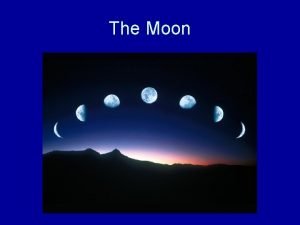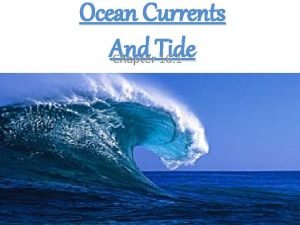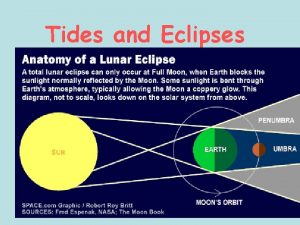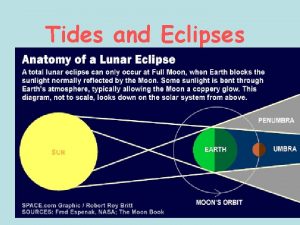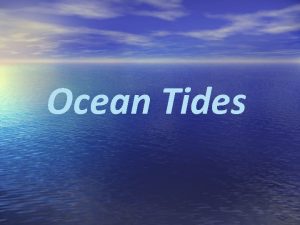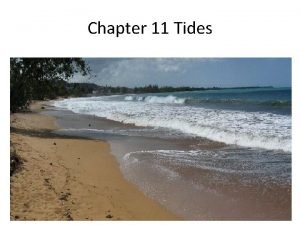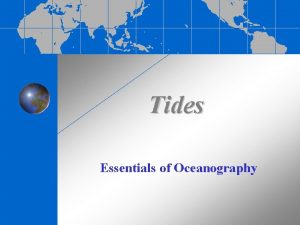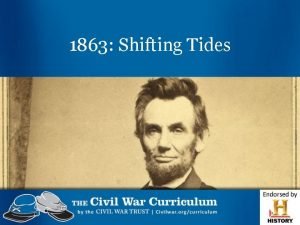TIDES There are two high tides and two











- Slides: 11

TIDES • There are two high tides and two low tides around the earth at any instant – High tides on longitude closest and farthest from the Moon and low tides at 90 o to this – Interval between high tides is ~ 12 hrs 25 mins • Tidal range is 0. 5 – 1 m in mid ocean but much larger on continental shelves Some examples of large tidal sites Country Site Range m Basin area km 2 Capacity GW Argentina Golfo Nuevo 3. 7 2376 6. 6 Canada Cobequid 12. 4 240 5. 3 India Gulf of Khambat 7. 0 1970 7. 0 Russia Mezen 6. 7 2640 15. 0 Russia Penzhinsk 11. 4 20530 87. 4 UK Severn 7 520 8. 6 11/5/2020 Lecture 5 1

PHYSICAL CAUSE OF TIDES • The Moon is the main cause. The Sun has ~ ½ the effect but this either increases or decreases the lunar tide depending on the relative positions of Earth, Moon and Sun. • The Earth’s rotation simply affects the location of the tides • To explain ignore the effect of the Sun for now Assume the Earth is covered with water Gravitational potential at P is f= -Gm / s and m is the lunar mass. d >> r 1/s = [d 2 + r 2 - 2 d r cosq] -1/2 = (1/d)[1 + {(-2 r/d)cosq + r 2/d 2}] -1/2 = (1/d)[1 + (r/d)cosq + (r 2/d 2){(3/2) cos 2 q -1/2 }+…] • 1 st term is constant (no force) and 2 nd gives a constant GM/d 2 providing centripetal acceleration for the Moon-Earth rotation • 3 rd describes the variation of the potential around the Earth 11/5/2020 Lecture 5 2

• Note that the reason for two tides is the combination of the variation of gravity across the Earth and the dynamics of the Moon-Earth system • The surface profile of the water is an equipotential surface due to the combined effects of the Earth and Moon – Potential of unit mass due to Earth’s gravitation is gh where h is the height above equilibrium level and g = GMEarth/r 2 • Hence the height of the tide h(q) is given by g h(q) - (Gmr 2/d 3){(3/2) cos 2 q -1/2 }= 0 (N. B. The equipotential constant is set to 0 because h is relative to the equilibrium level) h(q) = (Gmr 2/gd 3){(3/2) cos 2 q -1/2 }= hmax {(3/2) cos 2 q -1/2 } (5. 1) where hmax = Gmr 2/gd 3 = mr 4 / Md 3 since g = GM/r 2 • The maximum occurs when q = 0 or p • Putting m/M = 0. 0123, d = 384400 km and r = 6378 km gives hmax ≈ 0. 36 m which is roughly in line with observations 11/5/2020 Lecture 5 3

TIDAL WAVES • Consider a wave of small amplitude with l >> mean depth h 0. – Shallow water theory in which the vertical accelerations << g – Pressure below surface is roughly hydrostatic and at a height y above the sea bed it is given by p = p 0 +rg( h(x, t) – y) where y=h(x, t) is the wave profile and p 0 is the atmospheric pressure • 1 st consider the force on the vertical slice shown, of unit width, due to the change in pressure going from x to x+dx, i. e. p(x) p(x + dx) = p(x) + p/ x dx • Force in x direction = mass x acceleration = pressure difference x area so (1 hr dx) u/ t = - (1 h dx) p/ x =- h dx rg h/ x independent of y u/ t = -g h/ x for all y (5. 2) 11/5/2020 Lecture 5 4

• Next consider the continuity equation which says that the difference in volume flowing across the slice is equal to the volume displaced per second, vertically where v = h/ t i. e. uh = (u+du)(h+dh) + v dx = uh + hdu+udh + dh 2 + v dx Neglecting dh 2 and udh (<< hdu) and writing du= u/ x dx we get v dx = h/ t dx = -hdu = -h u/ x dx Taking h ≈ h 0 we obtain u / x= - (1/ h 0) h/ t (5. 3) Eliminating u between (5. 2 )and (5. 3) we obtain the wave eqn. 2 h / x 2= (1/ c 2) 2 h/ t 2 (5. 4) where c = (g h 0)1/2 (5. 5) • (5. 4) is the equation for the height profile h(x, t) • In fact the tidal bulges cannot keep up with the Earth’s rotation so the tides lag behind the position of the moon, e. g. At the equator h 0 = 4000 m so c = (9. 81 x 4000)1/2 = 198 ms-1 Speed of sea bed = 2 p x 6370 x 103/(24 x 60) = 463 ms-1 11/5/2020 Lecture 5 5

TIDAL POWER • A barrage across a river estuary allows water to accumulate in a tidal basin. This is then released through low-head turbines – Operates for a good fraction of the day – Choice of using conventional turbines (uni-directional) or less efficient turbines that can operate in either direction – Historically such schemes were used with water wheels to grind corn • 1 st large scale plant at La Rance, France in 1966 – 240 MW generated with 24 low head Kaplan turbines • A number of small plants have been built to investigate the ecological and environmental effects • Various proposals to build a barrage across the River Severn in UK have been turned down due to the large cost, public opposition and the availability of cheaper alternatives 11/5/2020 Lecture 5 6

POWER FROM A TIDAL BARRAGE • Let A be the area of the tidal basin and let h be the tidal range so that at full tide the level is h above the low water mark. Mass of water above Low level is m = r. Ah C of G is at ½ h Energy required to raise m by ½ h = 1/2 mgh= ½ rg. Ah 2 Average Power P = (rg. Ah 2 )/2 T where T is the tidal period (5. 6) e. g. The Severn Barrage would have A = 520 km 2 and tidal range h=7 m. Tidal period T ≈ 12. 5 h or 4. 5 104 s Check that (5. 6) estimates the power P to be ≈ 2. 8 GW 11/5/2020 Lecture 5 7

TIDAL RESONANCE • The tidal range varies in different oceans due to tidal resonance – Average depth of Atlantic is 4000 m so c ≈ 200 ms-1 – Tidal frequency ≈ 2 10 -5 Hz so l ≈ 200 / 2 10 -5 ≈ 104 km – This is ~ 2 x width of Atlantic and so resonance occurs; the time taken for a shallow wave to make the round trip ~5 104 s which is close to the tidal period ~ 4. 5 104 s – so the amplitude builds up • River estuaries can also exhibit large tidal resonance if the length and depth are favourable – Time for a wave to propagate down a channel of length L and back to the inlet is t = 2 L /(gh 0)1/2 – If this is equal to half the time between successive tides the tidal range is doubled 11/5/2020 Lecture 5 8

TIDAL RESONANCE IN A UNIFORM CHANNEL • Consider a channel of length L with a vertical wall at x=L and open to the sea at x=0 • Let the height of the incident tidal wave be hi(t)=a cos(wt) • Consider a travelling wave of form hi(x, t)=a cos(kx - wt) Mass Continuity u / x= - (1/ h 0) h/ t (5. 3) gives - ui / x= (1/ h 0) hi/ t = (wa/ h 0) sin(kx - wt) • Integrating with respect to x gives ui = (wa/ kh 0) cos(kx - wt) • In order to satisfy boundary conditions at x = 0 or L since there can be no flow across the barrier we superpose a reflected wave ur = (wa/ kh 0) cos(kx + wt) • Total velocity at x = L is u(L, t) = ui(L, t) + ur(L, t) =0 u(L, t) = (wa/ kh 0)[cos(k. L - wt) + cos(k. L + wt)] = (2 wa/ kh 0) cos k. L coswt = 0 k. L = p/2 so L= l/4 11/5/2020 Lecture 5 9

• The total height of the incident and reflected waves is h(x, t) = hi(x, t) + hr(x, t) = a cos(kx – wt) + a cos(kx – wt) h(x, t) = 2 a sin(kx) sin(wt) • At the end of the channel h(L, t) = 2 a sin(wt), i. e. double the amplitude. • This effect allows the amplitude to build up giving a tidal range of 10 – 14 m in the River Severn Example: Estimate the length of estuary required for tidal resonance if the average depth is 20 m Equating the time taken for a wave to travel the length of the channel and back again to half the tidal period we have 2 L / (9. 81 x 20)1/2 = ½ x 4. 5 104 so that L≈ 160 km 11/5/2020 Lecture 5 10

Tidal Currents • In some locations strong tidal currents exist (e. g. between islands) – Turbines with horizontal axes can be mounted on the sea bed or suspended from a floating platform to tap into the kinetic energy of the current – 1 st generation devices are underwater versions of wind turbines operating in shallow water (i. e. 20 -30 m) Impact on the ecology and environment • Barrages block navigation so systems of locks are required • Fish are killed in the turbines and impeded from migrating to spawning areas • Intertidal wet/dry habitat is altered affecting animals and plants • Natural flushing of silt / pollution is impeded affecting water quality • Tidal regime downstream may be affected. Proposed barrier in Bay of Fundy (Canada)could increase tidal range at Boston (1300 km away) by 0. 25 m 11/5/2020 Lecture 5 11
 Mikael ferm
Mikael ferm Compare and contrast spring tides and neap tides.
Compare and contrast spring tides and neap tides. Periodic rise and fall of sea level
Periodic rise and fall of sea level What causes tides
What causes tides Why are there tides
Why are there tides Pep unit
Pep unit There is there are countable uncountable nouns
There is there are countable uncountable nouns There's and there are
There's and there are What are tides and how are they caused
What are tides and how are they caused During which phase of the moon do neap tides occur
During which phase of the moon do neap tides occur Citlalli dominguez
Citlalli dominguez Spring and neap tides
Spring and neap tides


